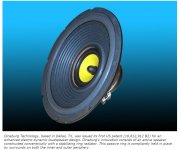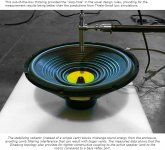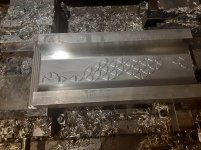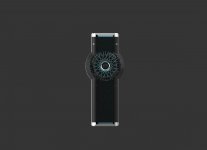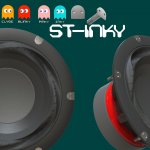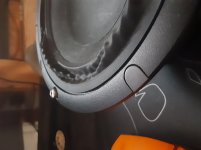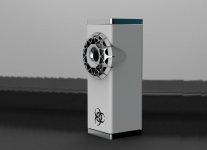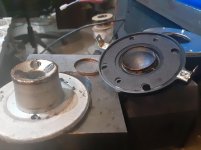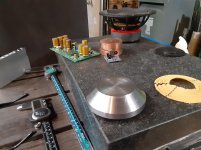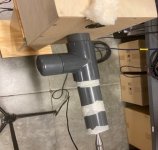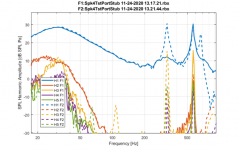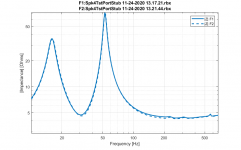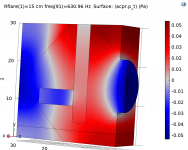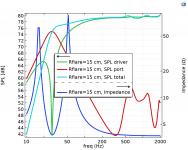Do you think we need an 'M' version of the 4"?
It appears to be a midrange with some reasonable low frequency ability to me.
I am having a hard time deliberating on the 4" or this 6.5M version for a mini monitor with sub woofer enhancement. I have built that currently with the standard PTT6.5 and it is terrific.
It appears to be a midrange with some reasonable low frequency ability to me.
I am having a hard time deliberating on the 4" or this 6.5M version for a mini monitor with sub woofer enhancement. I have built that currently with the standard PTT6.5 and it is terrific.
Not sure about "need"
When I design speakers the first thing I do is consider the room size/room volume.
Then listening position (eg. nearfield, 2m, or far-field eg. 5+ metres)
Then intended SPL.
This helps me narrow down my speaker size.
The original Purifi 6.5" was a unique product that allows me to build a small living room (~65m3) speaker that sets new standards in 0.5- 0.75cu ft.
If I had 40, 80, 160, 300+L, per speaker cabinet, that changes everything.
There are many 3-5" pure mids, and many 8-15" woofers to a make a very good 3 way with more dynamic capability...
When I design speakers the first thing I do is consider the room size/room volume.
Then listening position (eg. nearfield, 2m, or far-field eg. 5+ metres)
Then intended SPL.
This helps me narrow down my speaker size.
The original Purifi 6.5" was a unique product that allows me to build a small living room (~65m3) speaker that sets new standards in 0.5- 0.75cu ft.
If I had 40, 80, 160, 300+L, per speaker cabinet, that changes everything.
There are many 3-5" pure mids, and many 8-15" woofers to a make a very good 3 way with more dynamic capability...
Last edited:
Hi, i like your idea of concentric passive radiator, and i have actually read in latest issue of Audio Xpress about some company already developing it.Now comes that moment of confession that I didn't model the PTT driver lol! You can download it from Purifi, fyi. I'm both happily and painfully aware of this as I'd already spent many an hour modeling that surround and even have it available for download on the software forum. Solidworks and in the case of organic shapes a plugin called Powersurfacing are the modeling tools and I render in Keyshot.
Facing your prognosis of a concentric PR build, I'll have to weigh some options about how to proceed. One thing I really liked is the ability to stay very compact without a rear firing PR, and hence no wall proximity issues. Also, having learned of your out of phase/distance trouble, it seemed reasonable that direct alignment would be the most uniform position as far as how direct the suspension is loaded.
The Magico A1 is a reference for where I want to get in terms of build execution, so I have done a fair amount of modeling and comparing of that piece.
As to the patent.... nah, It's now safely in the world of prior art for us open sourcers 😉 If only it would do what's intended of it, but that's a whole different deal. It may be the perfect frisbee?
EDIT: I also added the original version with flat PR cone and upward facing surround for a sense of the many ways this can be configured.
The issue with your renderings seems to be, that the surface of the passive would be too small, given the size of the Purifi driver. The rule is to have the passive 2x, in some cases 3x the surface (sd) of the active driver.
Have a look on pics of the AudioXpress article, and you will see where i am aiming with this 😀
Attachments
@Adam Bernau,
Not sure if I should laugh or cry 🙄
To my mind the PR ring should be considered a coaxial speaker, unless there is some invisible secret sauce, BUT, my concept is validated I suppose. However, we still haven't any performance metric beyond whether it will make a usable frisbee!
To your point about 2x surface area, my versions are right at 2x the Purifi's surface area. Measured from center of the inner surround to the center of the outer surround. It appears to be a narrow ring, but don't forget that the increase in diameter adds up quick. The images you linked are way over 2x the area of the driver. From the looks of it, 4x or more.
I guess it's my move now, lol. That patent was filed in 2018 and my concept is mechanically similar; however, there are key differences. So I'll have to do some research on this patent and ascertain whether I have a parallel, competing "technology."
My understanding of intellectual property is that if something is shown to exist before a patent utility request for similar, the original creator is protected from the newly sought patent (for the similar concept) under the "Prior Art" clause.
We can see that the patented PR is a traditional basket held driver with an intermediary support and a secondary cone suspended, passively, between the driver and the outer basket. I acknowledge the creators intellectual property and do not seek to infringe upon it in any way. On the other hand, I have my own approach that is substantially unique in regards to the pre existing art. In this sense I will lay out some of my "Art", to be considered henceforth, "Prior Art."
In my iterations there is no basket, per se, and the outer PR surround is fixed to the baffle. The driver is supported via either a rear baffle connection, or an "X" brace straddling the PR ring and connecting with the front baffle.
Furthermore, the patented PR/driver in question has a traditional cone/driver continuation that extends past the drivers center emission plane. My concept PR ring is configurable in both alignment fore, center, or aft of the point source, as well as configurable geometrically. The PR geometry can include a plurality of geometries such as flat, convex, concave, ripple, eccentric, and so on.
Baffle intermediary. The patented design, by nature of traditional cone/driver geometry, is a continuation of the driver geometry. My concepts include continued geometry but also are able to employ PR discontinuity via a baffle ring intermediary. This allows concentric or eccentric, coaxial placement of the PR ring well beyond the bounds of a traditional basket driver.
Active coaxial woofer. The patented concept focuses mainly on a passive addition, suspended intermediately within a traditional driver cone/basket. My designs include active ring drivers powered via traditional voice coils.
Active ring woofer with inverse PR center (dreamed this up just now). Just take the concept and flip it. Taking my active ring driver, install a traditional PR in the center.
Coaxial Woofer/PR/Mid/Tweet Transmission Ring Enclosure. In the patent concept we see that there is no mention of reflection control (my assumption, haven't read more than a cursory amount on it). My integrated approach can facilitate a concentric TL baffle strategy, acting as a control for reflection as well as distance to PR surface. In other words, my driver is isolated from the PR, physically, and the transmission path can be configured in a plurality of geometries. In this way, the PR phase is tunable based both on my novel placement of the PR ring, for/center/aft, and via the tunable length TL capabilities.
FBF (Front Baffle Flexibility). My baffle ring intermediary concept will be configurable to either a PR ring suspended insert or a fixed diffraction control insert that can be tuned via a plurality of geometries.
Okay, now that I've written several thoughts down, I'll throw in various renditions of some of the mentioned concepts. Hopefully there is enough breathing room in the concepts I'm laying out that we can play around with them without getting a do not proceed letter for building passive coax speakers 😀
Not sure if I should laugh or cry 🙄
To my mind the PR ring should be considered a coaxial speaker, unless there is some invisible secret sauce, BUT, my concept is validated I suppose. However, we still haven't any performance metric beyond whether it will make a usable frisbee!
To your point about 2x surface area, my versions are right at 2x the Purifi's surface area. Measured from center of the inner surround to the center of the outer surround. It appears to be a narrow ring, but don't forget that the increase in diameter adds up quick. The images you linked are way over 2x the area of the driver. From the looks of it, 4x or more.
I guess it's my move now, lol. That patent was filed in 2018 and my concept is mechanically similar; however, there are key differences. So I'll have to do some research on this patent and ascertain whether I have a parallel, competing "technology."
My understanding of intellectual property is that if something is shown to exist before a patent utility request for similar, the original creator is protected from the newly sought patent (for the similar concept) under the "Prior Art" clause.
We can see that the patented PR is a traditional basket held driver with an intermediary support and a secondary cone suspended, passively, between the driver and the outer basket. I acknowledge the creators intellectual property and do not seek to infringe upon it in any way. On the other hand, I have my own approach that is substantially unique in regards to the pre existing art. In this sense I will lay out some of my "Art", to be considered henceforth, "Prior Art."
In my iterations there is no basket, per se, and the outer PR surround is fixed to the baffle. The driver is supported via either a rear baffle connection, or an "X" brace straddling the PR ring and connecting with the front baffle.
Furthermore, the patented PR/driver in question has a traditional cone/driver continuation that extends past the drivers center emission plane. My concept PR ring is configurable in both alignment fore, center, or aft of the point source, as well as configurable geometrically. The PR geometry can include a plurality of geometries such as flat, convex, concave, ripple, eccentric, and so on.
Baffle intermediary. The patented design, by nature of traditional cone/driver geometry, is a continuation of the driver geometry. My concepts include continued geometry but also are able to employ PR discontinuity via a baffle ring intermediary. This allows concentric or eccentric, coaxial placement of the PR ring well beyond the bounds of a traditional basket driver.
Active coaxial woofer. The patented concept focuses mainly on a passive addition, suspended intermediately within a traditional driver cone/basket. My designs include active ring drivers powered via traditional voice coils.
Active ring woofer with inverse PR center (dreamed this up just now). Just take the concept and flip it. Taking my active ring driver, install a traditional PR in the center.
Coaxial Woofer/PR/Mid/Tweet Transmission Ring Enclosure. In the patent concept we see that there is no mention of reflection control (my assumption, haven't read more than a cursory amount on it). My integrated approach can facilitate a concentric TL baffle strategy, acting as a control for reflection as well as distance to PR surface. In other words, my driver is isolated from the PR, physically, and the transmission path can be configured in a plurality of geometries. In this way, the PR phase is tunable based both on my novel placement of the PR ring, for/center/aft, and via the tunable length TL capabilities.
FBF (Front Baffle Flexibility). My baffle ring intermediary concept will be configurable to either a PR ring suspended insert or a fixed diffraction control insert that can be tuned via a plurality of geometries.
Okay, now that I've written several thoughts down, I'll throw in various renditions of some of the mentioned concepts. Hopefully there is enough breathing room in the concepts I'm laying out that we can play around with them without getting a do not proceed letter for building passive coax speakers 😀
Attachments
-
 image_2021-06-13_150656.png231.9 KB · Views: 979
image_2021-06-13_150656.png231.9 KB · Views: 979 -
 untitled.1933.jpg428.4 KB · Views: 917
untitled.1933.jpg428.4 KB · Views: 917 -
 untitled.1930.jpg384.8 KB · Views: 886
untitled.1930.jpg384.8 KB · Views: 886 -
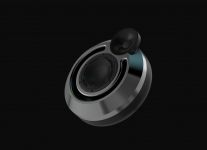 untitled.1926.png927.7 KB · Views: 217
untitled.1926.png927.7 KB · Views: 217 -
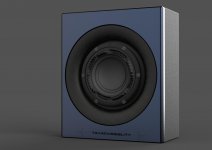 untitled.1819.jpg222.5 KB · Views: 224
untitled.1819.jpg222.5 KB · Views: 224 -
 untitled.1924.jpg178.7 KB · Views: 225
untitled.1924.jpg178.7 KB · Views: 225 -
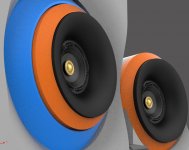 concentricDrive2.jpg73.3 KB · Views: 239
concentricDrive2.jpg73.3 KB · Views: 239 -
 untitled.1913.jpg137.3 KB · Views: 243
untitled.1913.jpg137.3 KB · Views: 243
Last edited:
Arrrrrg! 
I've been reading up on the above patent and found in a white paper they reference a patent from 2007 that is almost exactly what I came up with. Rear mount driver, essentially a separate unit from the PR. So the 2018 patent was basically a work around for the previous existing patent that my concept is similar to. Oh, the irony.
My personal take on these patents is they are B.S. Case in point; Norman Tracy ran into a phase issue with his tower PRs. I wanted to avoid that problem and had other issues to solve, such as enclosure compactness. Putting a concentric PR around the PTT6.5 seemed like an obvious solution that took all of about one minute to come up with. If you have a doctorate in physics and lay claim to the arrangement of drivers; yet some novice can come up with the exact same concept via basic principals like timing/alignment--well, what does that say about your intellectual property?
Indeed, Norman called my concept a coaxial speaker. I agree with that assessment 100% Not once did it cross my mind to try and lay claim to inventing a coaxial speaker, based on the technicality that it's not "powered." So those lovely vintage coaxial speakers of yesteryear are somehow less technologically advanced then putting a hole in a PR and adding one extra surround?
Maybe I'm overreacting but I gotta call out this problem. Big corps. are doing this crap all the time. I can recall Apple patenting basic construction procedures for composite fabrication. Those fine people literally have a patent on making carbon fiber "look glossy." And what does that patent consist of? Tried and true composite methods and techniques dating back to the 1950s. Yet somehow these fine people in the tech world get to throw barrels of cash around and own the rights to chew gum.
If a basic problem needs solved and a logical progression leads from A to B to C, then I'm sorry, that is not something you patent unless there is some exterior technology developed in the process. Taking speaker cones and butyl surrounds and arranging them in a certain recipe is not that. The bizarrely styled PTT6.5 surround is clearly NOT a random/obvious solution to a problem. What it is is a novel approach to the surround. It very clearly is a unique geometry, undoubtedly developed via intensive FEA and the like. Whatever it is, it's certainly not something I'd have come up with on a whim, to solve a basic need. It's not something I likely ever could have come up with, whether I was skilled in the art or not. But if I can go to the speaker repair website and order some foam surrounds, make a flat ring to glue them to, and put them around my PTT6.5 for kicks, welp, sorry, I do not find that scenario, as IP, to be convincing. But to whomever out there owns intellectual rights to putting cored out PRs around a driver....I thought this up, on my own, as a goof. We literally joked about its preferred application as a frisbee. I'm not trying to convince anyone that I, on my own, reinvented the wheel. What I'm saying is, your IP aint that clever. But since IP is clearly an issue with this generic/obvious idea, I do feel compelled to find workarounds. If I can take one minute to dream up coaxial PRs, I can take another ten to mock whomever decided to monopolize something that apparently has no real application, as I've never seen one IRL.
For starters: I hereby invent the dual use of concentric PRs as a frisbee double. This is the first ever application, soon to be patent pending. While it is true that the coaxial PR is distinct from run of the mill, blown, Kraco coaxial 6x9s in the back of a 69 Camaro, my invention is more akin to old-school Kraco tech. The key being that a non powered coaxial speaker is owned by smart scientists, and not to be encroached on. But the powered coaxial speaker is fair game. So in the spirit of fair play, my coax WILL be powered via nano receptors that harness to collective energy globally dissipated from blown Kracos blasting Nickelback. How this is accomplished is a trade secret. Come get some, patent trolls-

I've been reading up on the above patent and found in a white paper they reference a patent from 2007 that is almost exactly what I came up with. Rear mount driver, essentially a separate unit from the PR. So the 2018 patent was basically a work around for the previous existing patent that my concept is similar to. Oh, the irony.
My personal take on these patents is they are B.S. Case in point; Norman Tracy ran into a phase issue with his tower PRs. I wanted to avoid that problem and had other issues to solve, such as enclosure compactness. Putting a concentric PR around the PTT6.5 seemed like an obvious solution that took all of about one minute to come up with. If you have a doctorate in physics and lay claim to the arrangement of drivers; yet some novice can come up with the exact same concept via basic principals like timing/alignment--well, what does that say about your intellectual property?
Indeed, Norman called my concept a coaxial speaker. I agree with that assessment 100% Not once did it cross my mind to try and lay claim to inventing a coaxial speaker, based on the technicality that it's not "powered." So those lovely vintage coaxial speakers of yesteryear are somehow less technologically advanced then putting a hole in a PR and adding one extra surround?
Maybe I'm overreacting but I gotta call out this problem. Big corps. are doing this crap all the time. I can recall Apple patenting basic construction procedures for composite fabrication. Those fine people literally have a patent on making carbon fiber "look glossy." And what does that patent consist of? Tried and true composite methods and techniques dating back to the 1950s. Yet somehow these fine people in the tech world get to throw barrels of cash around and own the rights to chew gum.
If a basic problem needs solved and a logical progression leads from A to B to C, then I'm sorry, that is not something you patent unless there is some exterior technology developed in the process. Taking speaker cones and butyl surrounds and arranging them in a certain recipe is not that. The bizarrely styled PTT6.5 surround is clearly NOT a random/obvious solution to a problem. What it is is a novel approach to the surround. It very clearly is a unique geometry, undoubtedly developed via intensive FEA and the like. Whatever it is, it's certainly not something I'd have come up with on a whim, to solve a basic need. It's not something I likely ever could have come up with, whether I was skilled in the art or not. But if I can go to the speaker repair website and order some foam surrounds, make a flat ring to glue them to, and put them around my PTT6.5 for kicks, welp, sorry, I do not find that scenario, as IP, to be convincing. But to whomever out there owns intellectual rights to putting cored out PRs around a driver....I thought this up, on my own, as a goof. We literally joked about its preferred application as a frisbee. I'm not trying to convince anyone that I, on my own, reinvented the wheel. What I'm saying is, your IP aint that clever. But since IP is clearly an issue with this generic/obvious idea, I do feel compelled to find workarounds. If I can take one minute to dream up coaxial PRs, I can take another ten to mock whomever decided to monopolize something that apparently has no real application, as I've never seen one IRL.
For starters: I hereby invent the dual use of concentric PRs as a frisbee double. This is the first ever application, soon to be patent pending. While it is true that the coaxial PR is distinct from run of the mill, blown, Kraco coaxial 6x9s in the back of a 69 Camaro, my invention is more akin to old-school Kraco tech. The key being that a non powered coaxial speaker is owned by smart scientists, and not to be encroached on. But the powered coaxial speaker is fair game. So in the spirit of fair play, my coax WILL be powered via nano receptors that harness to collective energy globally dissipated from blown Kracos blasting Nickelback. How this is accomplished is a trade secret. Come get some, patent trolls-
Last edited:
Patent Jailbreak
Having gotten a little flaming off my chest, I'm going to try and be more diplomatic in my approach. Concentric PR related stuff is now something I will discuss on a separate thread.
The concept I had planned on attempting is apparently locked up, intellectually. So it looks like I'm gonna have to plan an IP jailbreak. Will it be via tunnel? Helicopter? Let's find out- Activator 9K1...Patent Jailbreak
P.S. No offence to those with existing IP along these lines. I got a little heated and to be fair, no one has told me to cease doing anything as of yet. But realize that I came up with a specific concept, independently, and was happy to share it with the DIY community. I didn't try and clamp it down, even having assumed it had not been previously fleshed out. Titans like Pappa P have been extremely generous with sharing their IP and that is something that I aspire to.
Having gotten a little flaming off my chest, I'm going to try and be more diplomatic in my approach. Concentric PR related stuff is now something I will discuss on a separate thread.
The concept I had planned on attempting is apparently locked up, intellectually. So it looks like I'm gonna have to plan an IP jailbreak. Will it be via tunnel? Helicopter? Let's find out- Activator 9K1...Patent Jailbreak
P.S. No offence to those with existing IP along these lines. I got a little heated and to be fair, no one has told me to cease doing anything as of yet. But realize that I came up with a specific concept, independently, and was happy to share it with the DIY community. I didn't try and clamp it down, even having assumed it had not been previously fleshed out. Titans like Pappa P have been extremely generous with sharing their IP and that is something that I aspire to.
Hi HazeH,
Sorry about your IP woes. But just because there is a patent that says your idea has already been claimed, doesn’t make it a bad idea. You still have implementation, and more ideas will come. Take it from someone who has done this more than a dozen times successfully - don’t expect your first idea to be original or to make you money. It’s a numbers game and you need the numbers. Talk to a patent attorney before disclosing ideas that you feel are special. Note well: the moment you publicly posted (disclosed) your idea, a 1 yr clock starts ticking for you to file for a US patent. However, many countries in the EU will now basically be impossible for you to get a patent since you will not be able to prove “absolute originality” later on. But don’t worry about patents - only 1 in 10 become real products that get licensed and make any money. Look at how many there are in the world. The world is a big place, filled with a lot of creative people. Keep trying and doing what you do - you have great ideas.
Sorry about your IP woes. But just because there is a patent that says your idea has already been claimed, doesn’t make it a bad idea. You still have implementation, and more ideas will come. Take it from someone who has done this more than a dozen times successfully - don’t expect your first idea to be original or to make you money. It’s a numbers game and you need the numbers. Talk to a patent attorney before disclosing ideas that you feel are special. Note well: the moment you publicly posted (disclosed) your idea, a 1 yr clock starts ticking for you to file for a US patent. However, many countries in the EU will now basically be impossible for you to get a patent since you will not be able to prove “absolute originality” later on. But don’t worry about patents - only 1 in 10 become real products that get licensed and make any money. Look at how many there are in the world. The world is a big place, filled with a lot of creative people. Keep trying and doing what you do - you have great ideas.
Article in The Audio Voice 10 June 2021 with concept similar to Haze Head's PR coax. I agree that perhaps time to cleve this topic off to its own thread. I did want to make sure you have this input.
View attachment Dinaburg The Audio Voice 10June2021.pdf
P.S. The design renders presented in post #804 are...amazing.
View attachment Dinaburg The Audio Voice 10June2021.pdf
P.S. The design renders presented in post #804 are...amazing.
Last edited:
@Norman, glad you like them! I kept thinking the round ones reminded me of something and then I realized.... bedpan 😀 Also, thx for the pdf link.
@X, I appreciate your advice. This isn't the first time I ran into an IP wall. Barking at the patent holders was less ad hominem then probably came across. What I mean is that this is more like the nth time I've hit IP roadblocks and I finally threw my tools at the wall and shouted obscenities at anyone within hearing range. Maybe it really does perform well, but I'm still throwing wrenches and cursing at it. I suppose I could bow out quietly but right at the moment I'm harvesting a decade worth of IP roadblocks, all at once, and trying to channel it into something free of restrictions. I don't take it too seriously. Just fired up!
@X, I appreciate your advice. This isn't the first time I ran into an IP wall. Barking at the patent holders was less ad hominem then probably came across. What I mean is that this is more like the nth time I've hit IP roadblocks and I finally threw my tools at the wall and shouted obscenities at anyone within hearing range. Maybe it really does perform well, but I'm still throwing wrenches and cursing at it. I suppose I could bow out quietly but right at the moment I'm harvesting a decade worth of IP roadblocks, all at once, and trying to channel it into something free of restrictions. I don't take it too seriously. Just fired up!
Hi Haze Head,
I like your creative approach, i think that the most important step for you now would be creating fully functional prototype(s). It´s nice that you have designed this interesting PR solution, but keep in mind, that from conceptual sketch to working and reliable prototype, manufactured for reasonable price is very, very long way, been there, done that 🙂A lot of new issues and challenges will rise, when you actually start to materialise your ideas, but you will also move forward significantly in the direction, that doesn´t exist in the safe world of nice 3D models and renderings.
I am trying to understand your posted section shot- so the passive radiator diaphragm is the triangular shape on the left side of the section?
It has double suspension on the inner circle, and the same on the outer, fixed to the enclosure? I don´t see the advantage of this approach... So you will glue the outer suspension of the passive ring to the hole in speaker enclosure forever, without future possibility to replace the part, when it breaks?
I also don´t understand the advantages of the non-solid driver mount with brace behind, could you perhaps explain what this approach brings compared to normal passive with basket, or the double suspension in my link above?
Anyway, keep up the good work, i wish you luck and i will observe where this goes!
I like your creative approach, i think that the most important step for you now would be creating fully functional prototype(s). It´s nice that you have designed this interesting PR solution, but keep in mind, that from conceptual sketch to working and reliable prototype, manufactured for reasonable price is very, very long way, been there, done that 🙂A lot of new issues and challenges will rise, when you actually start to materialise your ideas, but you will also move forward significantly in the direction, that doesn´t exist in the safe world of nice 3D models and renderings.
I am trying to understand your posted section shot- so the passive radiator diaphragm is the triangular shape on the left side of the section?
It has double suspension on the inner circle, and the same on the outer, fixed to the enclosure? I don´t see the advantage of this approach... So you will glue the outer suspension of the passive ring to the hole in speaker enclosure forever, without future possibility to replace the part, when it breaks?
I also don´t understand the advantages of the non-solid driver mount with brace behind, could you perhaps explain what this approach brings compared to normal passive with basket, or the double suspension in my link above?
Anyway, keep up the good work, i wish you luck and i will observe where this goes!
Attachments
Thanks, Adam, I appreciate the feedback.
As far as that particular setup, and every other iteration I've worked on, the PTT6 is always supported, in this case from the rear baffle. Correct, the darker triangle part is the PR, but don't read too much into the minutiae, as no fine detail is worked out. For instance, obviously you wouldn't want a solid PR, heavy from that thick cross section. But you did hone in on the more important aspect of that configuration, being the inline, axial surrounds.
What I was attempting has, in part, to do with off-the-shelf surrounds readily available, in part to do with making the OD as small as possible, and in part to have a more balanced suspension profile. What I mean by that is I've a concern over the mechanical performance of having an inner and outer surround that will likely have differing excursion "resistance" profiles; unless custom surrounds are designed according to this specific application. I have no problem taking that on, but my material of choice, polyether, is not something I can seem to readily get my hands on.
That model uses dimensions that are tailored for the JL Audio 10W7 surround IIRC. Or maybe it was an 8," I forget. That particular render definitely has some issues but the main takeaway is the surrounds are 1: equally loaded 2: off-the-shelf 3: configured uniquely apart from any of the pre-existing patents. The direction I was headed was that in order to create a more stable PR suspension geometry, I could increase the axial distance between each inline surround, creating a triangular relationship between the PR and each surround.
Regarding the use of renderings vs. real life implementation, I understand what you're saying, and it's definitely true. What I've come to realize about those unforeseen realization pitfalls is that they can almost always be attributed to incomplete modeling. It's often some trivial detail left out of a model that turns into a major headache when reconciling it on the shop floor. After years of noticing this I've grown accustomed to spending most of the time on models and as a consequence it takes major motivation to finally move into the physical realm. It's such a divide that I'll occasionally make something IRL just to buck that habit. But to keep this about the PTT6 I'll add a couple of IRL experiments, contrasted with initial renders.
In homage to the PTT6s low distortion properties, a few parts have been liberated from their bar stock prisons, some more successfully than others. With a little fanaticism about clean lines around the fastener mounts, there are the "INKY" flush mount bolts that are contoured to match the PTT6. Most recent work is on a baffle mold for a slimline, non-PR version for a coaxial PTT build. Also, work is underway on an integrated coax tweeter as part of a grill. The Dayton soft dome is too tall so it's being hacked to use thin neodymiums and a custom thin magnet frame that will allow the tweeter to be sunken in closer with the PTT6 cone. It's something that may or may not ever get completed, but I can say with certainty that if not, it's for lack of an absolute complete model. One final thought about models; that this forum is so model friendly is something I love about it. Over at DIY Solar I would hash out concepts via models and really take a beating over it. It was bad enough that I was making memes about poo pooing models before you've seen the size ones drill bits 😀
As far as that particular setup, and every other iteration I've worked on, the PTT6 is always supported, in this case from the rear baffle. Correct, the darker triangle part is the PR, but don't read too much into the minutiae, as no fine detail is worked out. For instance, obviously you wouldn't want a solid PR, heavy from that thick cross section. But you did hone in on the more important aspect of that configuration, being the inline, axial surrounds.
What I was attempting has, in part, to do with off-the-shelf surrounds readily available, in part to do with making the OD as small as possible, and in part to have a more balanced suspension profile. What I mean by that is I've a concern over the mechanical performance of having an inner and outer surround that will likely have differing excursion "resistance" profiles; unless custom surrounds are designed according to this specific application. I have no problem taking that on, but my material of choice, polyether, is not something I can seem to readily get my hands on.
That model uses dimensions that are tailored for the JL Audio 10W7 surround IIRC. Or maybe it was an 8," I forget. That particular render definitely has some issues but the main takeaway is the surrounds are 1: equally loaded 2: off-the-shelf 3: configured uniquely apart from any of the pre-existing patents. The direction I was headed was that in order to create a more stable PR suspension geometry, I could increase the axial distance between each inline surround, creating a triangular relationship between the PR and each surround.
Regarding the use of renderings vs. real life implementation, I understand what you're saying, and it's definitely true. What I've come to realize about those unforeseen realization pitfalls is that they can almost always be attributed to incomplete modeling. It's often some trivial detail left out of a model that turns into a major headache when reconciling it on the shop floor. After years of noticing this I've grown accustomed to spending most of the time on models and as a consequence it takes major motivation to finally move into the physical realm. It's such a divide that I'll occasionally make something IRL just to buck that habit. But to keep this about the PTT6 I'll add a couple of IRL experiments, contrasted with initial renders.
In homage to the PTT6s low distortion properties, a few parts have been liberated from their bar stock prisons, some more successfully than others. With a little fanaticism about clean lines around the fastener mounts, there are the "INKY" flush mount bolts that are contoured to match the PTT6. Most recent work is on a baffle mold for a slimline, non-PR version for a coaxial PTT build. Also, work is underway on an integrated coax tweeter as part of a grill. The Dayton soft dome is too tall so it's being hacked to use thin neodymiums and a custom thin magnet frame that will allow the tweeter to be sunken in closer with the PTT6 cone. It's something that may or may not ever get completed, but I can say with certainty that if not, it's for lack of an absolute complete model. One final thought about models; that this forum is so model friendly is something I love about it. Over at DIY Solar I would hash out concepts via models and really take a beating over it. It was bad enough that I was making memes about poo pooing models before you've seen the size ones drill bits 😀
Attachments
@ Haze Head
All you have to be is 10% different than another person's patent to be not infringing upon it.
And take note of this. A patent does not protect you. It gives you the right to sue anyone that infringes upon your patent rights. And that is if you can afford to sue them. Remember that 10% rule. If they have made changes to your patent that accumulate to 10% different you will loose that law suit.
Your renderings do not provide enough information to be patented so don't worry.
All you have to be is 10% different than another person's patent to be not infringing upon it.
And take note of this. A patent does not protect you. It gives you the right to sue anyone that infringes upon your patent rights. And that is if you can afford to sue them. Remember that 10% rule. If they have made changes to your patent that accumulate to 10% different you will loose that law suit.
Your renderings do not provide enough information to be patented so don't worry.
The ten percent rule definitely jives with a lot of the "slightly different" patents I've seen out there.
As far as what the patent does, what you mentioned has been my understanding. I don't have any desire for a patent, at least not with this particular stuff; it was more a concern over infringing something out there, but I have enough variations at this point to hopefully be okay. Just today the most promising config. occurred to me yet, so these convos. have been quite fruitful. I don't want to stray too far afield on mainframe99's build thread. On the other hand, this is all Purfi geared so anyone wanting to experiment with the PR concepts now has much of the detail at their disposal. The latest iteration should be fairly reasonable to DIY, using off the shelf surrounds. It uses the inline suspension concept but the PR acts as the edge of the baffle which really simplifies the problem and almost perfectly solves how to connect the two surrounds without tricky mechanical 'routing'. But I probably won't post any more on coaxial PRs unless one gets built or someone has a question about it.
I checked out your site BTW. Good stuff!
As far as what the patent does, what you mentioned has been my understanding. I don't have any desire for a patent, at least not with this particular stuff; it was more a concern over infringing something out there, but I have enough variations at this point to hopefully be okay. Just today the most promising config. occurred to me yet, so these convos. have been quite fruitful. I don't want to stray too far afield on mainframe99's build thread. On the other hand, this is all Purfi geared so anyone wanting to experiment with the PR concepts now has much of the detail at their disposal. The latest iteration should be fairly reasonable to DIY, using off the shelf surrounds. It uses the inline suspension concept but the PR acts as the edge of the baffle which really simplifies the problem and almost perfectly solves how to connect the two surrounds without tricky mechanical 'routing'. But I probably won't post any more on coaxial PRs unless one gets built or someone has a question about it.
I checked out your site BTW. Good stuff!
Last edited:
Haze head, there's no off topics here so long as its about the purifi woofer - so you're all good! The thread has morphed into just about all things purifi and its all good discussion. I dont know if we've quite mastered the 6.5 yet but it certainly seems to be most popular with passive radiator alignments!
Amazing renders btw.
Amazing renders btw.
Recommendations for sealed sub driver to complement Purifi
Greetings, apologies if this is wavering off topic.
As some may recall I have built some sealed enclosures for the PTT6.5 8 ohm version. I have these running to 100 hz and then to an electronic low passed 15" sub that is slot loaded. These certainly dig the lower frequencies out of the music and have huge ability to play loud but I feel the integration is not spot on and sounds a little slow and thick and the enclosures are too big at 90 litres. However the sound of the purify equipped monitors is outstanding with incredible detail and almost spooky imaging.
My next plan is to build sealed enclosures with probably 10-12" drivers in as small as practical enclosures. I am not chasing 'flat to 20' bass response but want tight and controlled lows. I have 250 watts of bass amp power in a very nice Holton lateral mosfet power amp, 45 square metre room and listen less than 80db-A max. Budget is ok for top level drivers but I don't like wasting money if something less can do the job.
I am looking for suggestions for drivers that may be worth considering. Seas and Peerless seem to have some likely candidates but I have no experience with them. Thanks for any recommendations
Greetings, apologies if this is wavering off topic.
As some may recall I have built some sealed enclosures for the PTT6.5 8 ohm version. I have these running to 100 hz and then to an electronic low passed 15" sub that is slot loaded. These certainly dig the lower frequencies out of the music and have huge ability to play loud but I feel the integration is not spot on and sounds a little slow and thick and the enclosures are too big at 90 litres. However the sound of the purify equipped monitors is outstanding with incredible detail and almost spooky imaging.
My next plan is to build sealed enclosures with probably 10-12" drivers in as small as practical enclosures. I am not chasing 'flat to 20' bass response but want tight and controlled lows. I have 250 watts of bass amp power in a very nice Holton lateral mosfet power amp, 45 square metre room and listen less than 80db-A max. Budget is ok for top level drivers but I don't like wasting money if something less can do the job.
I am looking for suggestions for drivers that may be worth considering. Seas and Peerless seem to have some likely candidates but I have no experience with them. Thanks for any recommendations
Damping Port pipe modes
Hi,
For inspiration, I would like to share a few results on how to improve a port. The PTT6.5 has a low Vas and low fs which enables very deep bass out of a small volume bass. The challenge is that the port gets quite long if it should keep a reasonable port wind speed. This moves the pesky port pipe modes down in frequency where they do more damage. The use of a PR avoids this problem but the PR system is now a 5th order system whereas the ported is only 4th order. The free air resonance of the PR causes a notch in the SPL response which causes a faster bass roll off compared to a port with the same tuning. This also shows up in the time domain where the PR system will have more ringing than the ported system for the same bass extension.
An interesting observation is that both ports and PR's transmit the internal standing modes inside the box. Both act as a mass loaded piston that gets accelerated by the air pressure acting on it. The counterintuitive result is that ports and PR's are quite similar in this respect.
But back to the pipe modes of the port. Several methods are used to reduce the impact of these modes. Port placement makes quite a difference (the pressure inside the box is not uniform so finding the optimum placmeent of the inside port mouth can help quite a bit). However, for a small box with a long port, the optios are limited. Alternatively, damping can be applied. The simplest trick is to perforrate the port at e.g. the middle where the pressure is at maximum for the first pipe mode (port length is half a wavelength). This is quite effective but the perforation also shortens the ort effectively. Another approach is to line the port with damping material (the port diameter must be adjusted to have the same free diameter of air flow. This is difficult to do in practice and the air flow easily gets restricted which lowers the Q of the port.
The method I find most attactive is to add one or more stubs to the port and fill the stub with damping material. This does not block the air flow but effectively damps the pipe modes.
The attached picture shows an experiment with a 57mm ID port pipe with a stub (made using std plumbing parts). Also shown are the port near field SPL with and without the stub. The Q of the pipe modes is reduced drastically and so is the SPL. The impedance graph reveals that the box tuning (frequency and depth of the impedance saddle point) is close to unaffected. Note that the box is empty so the box mode at 600Hz is unchanged by the addition of the stub. These modes need box filling to be taken out.
I have made a simple model in Comsol to simulate the box and port. This allows me to estimate the far field SPL when summing the driver and port outputs. An untamed pipe mode typically causes a deep cancellation dip and a peak. This may not be so visible at gated measurements at a short distance (the box shadows for a port mouth on the back) but will show up in the radiated power and as deep dips in the SPL in the far field. Note that using the damped stub, the summed SPL only has very small ripples across the port mode.
best of luck to you all and thanks for using our drivers,
Lars @PURIFI
Hi,
For inspiration, I would like to share a few results on how to improve a port. The PTT6.5 has a low Vas and low fs which enables very deep bass out of a small volume bass. The challenge is that the port gets quite long if it should keep a reasonable port wind speed. This moves the pesky port pipe modes down in frequency where they do more damage. The use of a PR avoids this problem but the PR system is now a 5th order system whereas the ported is only 4th order. The free air resonance of the PR causes a notch in the SPL response which causes a faster bass roll off compared to a port with the same tuning. This also shows up in the time domain where the PR system will have more ringing than the ported system for the same bass extension.
An interesting observation is that both ports and PR's transmit the internal standing modes inside the box. Both act as a mass loaded piston that gets accelerated by the air pressure acting on it. The counterintuitive result is that ports and PR's are quite similar in this respect.
But back to the pipe modes of the port. Several methods are used to reduce the impact of these modes. Port placement makes quite a difference (the pressure inside the box is not uniform so finding the optimum placmeent of the inside port mouth can help quite a bit). However, for a small box with a long port, the optios are limited. Alternatively, damping can be applied. The simplest trick is to perforrate the port at e.g. the middle where the pressure is at maximum for the first pipe mode (port length is half a wavelength). This is quite effective but the perforation also shortens the ort effectively. Another approach is to line the port with damping material (the port diameter must be adjusted to have the same free diameter of air flow. This is difficult to do in practice and the air flow easily gets restricted which lowers the Q of the port.
The method I find most attactive is to add one or more stubs to the port and fill the stub with damping material. This does not block the air flow but effectively damps the pipe modes.
The attached picture shows an experiment with a 57mm ID port pipe with a stub (made using std plumbing parts). Also shown are the port near field SPL with and without the stub. The Q of the pipe modes is reduced drastically and so is the SPL. The impedance graph reveals that the box tuning (frequency and depth of the impedance saddle point) is close to unaffected. Note that the box is empty so the box mode at 600Hz is unchanged by the addition of the stub. These modes need box filling to be taken out.
I have made a simple model in Comsol to simulate the box and port. This allows me to estimate the far field SPL when summing the driver and port outputs. An untamed pipe mode typically causes a deep cancellation dip and a peak. This may not be so visible at gated measurements at a short distance (the box shadows for a port mouth on the back) but will show up in the radiated power and as deep dips in the SPL in the far field. Note that using the damped stub, the summed SPL only has very small ripples across the port mode.
best of luck to you all and thanks for using our drivers,
Lars @PURIFI
Attachments
Nice one Lars, thank you. Confirms my original thought, and I am working on that solution already. The port stub can be easily hidden if building a floorstander by running the port through the false cabinet below the main woofer cabinet.
Seas and Peerless seem to have some likely candidates but I have no experience with them. Thanks for any recommendations
This isn't in your mentions and is for an open config. But hey, If your going compact, hard to beat ditching the cab all together. Plus it's on my wish list and want to see how it does with a PTT build 😉 -
Acoustic Elegance Dipole15 woofer for Open Baffle Applications
Thanks Haze Head. I don't think I will go in this direction.
I feel the open baffle for the bottom is not going to enhance much on what the Purifi already delivers. However it looks an interesting driver in another implementation.
I think all sealed will be easier to integrate and I like a tighter sound accepting the lowest registers may be a bit subdued.
I feel the open baffle for the bottom is not going to enhance much on what the Purifi already delivers. However it looks an interesting driver in another implementation.
I think all sealed will be easier to integrate and I like a tighter sound accepting the lowest registers may be a bit subdued.
- Home
- Loudspeakers
- Multi-Way
- Exploring Purifi Woofer Speaker Builds
